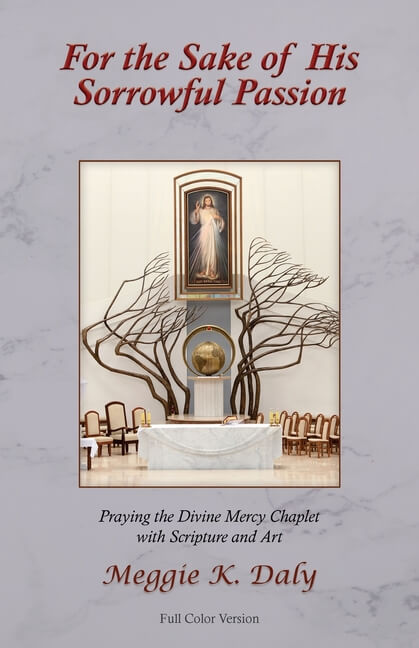Genre
Devotional, non-fiction
Audience
Adults, Young Adults
Author’s Worldview
Catholic
Year Published
2020
Themes
Divine Mercy, forgiveness, love, St. Faustina, rosary, prayer, art, devotional, conversion, reconciliation, Divine Mercy Chaplet, Stations of the Cross, mercy
Reviewed by
Dr. Lisa Theus
If repetitive prayer is a struggle for you, Meggie Daly’s For the Sake of His Sorrowful Passion will be a welcome companion. Part testimonial, part history, and part devotional, this book leads the reader to a profound love of the Divine Mercy Chaplet. The focus of the book is the devotional. Daly makes no claims that this is the way to pray the Divine Mercy Chaplet, but she provides a friendly, thoughtful sample of sources and reflections to help your focus. For many of us, the help is welcome. Repetitive prayer can often become just that – repetition without spiritual fruit. Tips and aids for slowing down and devoting a few minutes more fully to prayer both help us to concentrate and allow God to speak to us in new ways.
But all three parts (testimonial, historical background, and devotional) serve an important role in providing context and motivation to include the Divine Mercy Chaplet in your prayer life. In the first part, Meggie Daly shares some of her conversion story, showing how the Divine Mercy of Jesus formed a thread in her return to the Church. In the second part, she introduces us to St. Faustina and the historical context of the devotion. Finally, she provides art, scripture, and reflection sentences to encourage a slower, deeper prayer time focusing on the Passion narrative.
The three parts complement each other perfectly. While the focus of the book is the devotional art, the testimonial and historical sections provide welcome context and encouragement. And no section overstays its welcome – readers who love testimonials will certainly want to know more about Daly’s story, and people wholly unfamiliar with the history of the Divine Mercy Chaplet have much still to discover, but in my opinion, both are at just the right length to provide the need-to-knows. I felt satisfied by each section, and although I’ve read St. Faustina’s diary and consider myself familiar with the Divine Mercy devotion, I still found new and interesting tidbits throughout the book.
With its content, the book might not appeal outside of a Catholic audience. Daly’s conversion story is beautiful – and certainly not condemning of other Christian paths – but people personally skeptical or disinterested in the Church are unlikely to be persuaded or interested in hearing her view on how the Church really is merciful and has their best interests in heart. Still, I would love to get this in the hands of Catholics who identify as Catholics but struggle or even refuse to accept aspects of the faith. An encouraging word from someone who returned fully to the faith may provide a kindly nudge. The book is best, however, for Catholics curious about the Divine Mercy devotion who want an easy-to-read, friendly introduction to it; and for Catholics familiar with it who want a fresh approach.
My personal recommendation is to splurge on the physical, color edition of the book. Half of the book is devoted to a scriptural and artistic method of devotion, and a physical printing of the art makes it much easier to put aside distractions and practice meditative prayer. But whichever version is best for you, you’ll find it helpful, easy-to-read, and easy-to-use.



